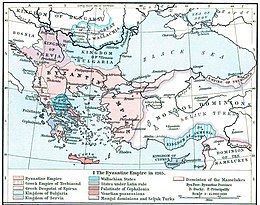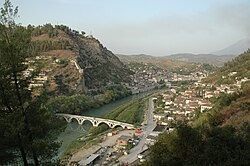Siege of Berat (1280–1281)
| Siege of Berat | |||||||
|---|---|---|---|---|---|---|---|
| Part of the Byzantine–Latin Wars | |||||||
 Map of the Byzantine Empire and the surrounding states in 1265. | |||||||
| |||||||
| Belligerents | |||||||
| Byzantine Empire | Angevin Kingdom of Sicily | ||||||
| Commanders and leaders | |||||||
|
Michael Tarchaneiotes John Synadenos (megas stratopedarches) Demetrios Micheal Angelos | Hugh of Sully (POW) | ||||||
| Strength | |||||||
| unknown |
2,000 knights 6,000 men-at-arms | ||||||
| Casualties and losses | |||||||
| unknown | heavy | ||||||
The siege of Berat in
Background
Ever since the Emperor
In 1258, the Sicilians took possession of the island of
Michael VIII countered the emerging threat by a diplomatic mission to the Papacy, which in the Second Council of Lyon (1274) agreed to the union of the Orthodox and Catholic churches, estranged after the Great Schism of 1054, and thereby placed Michael and his empire under papal protection. Taking advantage of Charles's entanglement in the conflict between Guelphs and Ghibellines in Italy, in spring 1274 Michael launched an attack against Angevin holdings in Albania. Berat and Buthrotum were taken and Charles's troops were pushed back from the hinterland to the two ports of Valona and Dyrrhachium. Although these were assaulted several times in 1274–1275, they remained in Angevin hands.[4]
By 1279 however, Charles had established his control not only over the Latin states of Greece (after 1278 he was the
The siege


In August/September 1280, with an army of 2,000 knights and 6,000 infantry, Sully began his attack by storming the fortress of Kanina and then advancing to central Albania and laying siege to Bellegrada. The situation was grave for Byzantium: Bellegrada was, in the words of the historian
Meanwhile, the siege of Bellegrada continued through the winter of 1280/1281. By early December, the Angevin forces had seized a number of outlying forts around the city and penetrated its suburbs. Charles, however, remained anxious to take the city before the Byzantine relief force arrived. He ordered his governors in Albania to direct all their resources towards the siege, and displayed his close interest by a series of letters to Sully, instructing him to take the city by assault if necessary.[9] The Byzantine force advanced cautiously, and arrived in the area in early spring 1281. The megas domestikos Tarchaneiotes avoided a direct confrontation and relied on ambushes and raids instead. He also managed to resupply the besieged fortress with provisions, which were loaded onto rafts and then left to float down the river Osum which flows by the citadel.[10]
The besiegers became aware of this, and, unlike the Byzantines, the Angevin commanders were eager for a decisive confrontation. At this point, Sully resolved to reconnoitre the area personally, accompanied only by a bodyguard of 25 men. As he approached the Byzantine camp, he fell into an ambush by Turkish mercenaries serving in the Byzantine army. The Turks attacked the small troop, killed Sully's horse, scattered his guard, and captured him.
Aftermath
The victory at Bellegrada represented Michael VIII's greatest success in battle over the Latins since the Battle of Pelagonia 20 years earlier. The many prisoners, including Sully, were taken to Constantinople, where they were publicly paraded in a triumph celebrated by the exultant emperor, who further ordered frescoes depicting scenes from the campaign painted in his palace.[13] In the aftermath of their victory at Bellegrada, the imperial troops restored their control over Albania, except the two Angevin strongholds of Dyrrachium and Aulon. The defeat ended Charles's designs of an overland assault on Byzantium, but the Angevin ruler now redoubled his efforts, aiming to launch a seaborne invasion of the Empire with Venetian aid.[14] This he secured with the Treaty of Orvieto in 1281. The Papacy also, after the election of the pro-Angevin Martin IV, finally sanctioned his plans, excommunicating Michael Palaiologos and ending the Union of the Churches. Michael VIII countered this with an alliance with Peter III of Aragon (r. 1276–1285), and with his support to various anti-Angevin forces in Italy. Just as Charles was ready to launch his attack, an uprising known as the Sicilian Vespers broke out on March 30, 1282. The subsequent wars, in large part the result of Michael's diplomatic efforts, ended the threat of Charles on Byzantium.[15]
References
- ^ Fine 1994, pp. 156–170, 184–194; Geanakoplos 1959, pp. 47ff., 139ff., 189–190.
- ^ Geanakoplos 1959, pp. 49–50, 235; Setton 1976, pp. 81, 109–110.
- ^ Fine 1994, pp. 184–185; Geanakoplos 1959, pp. 233–234.
- ^ Geanakoplos 1959, pp. 279–280; Nicol 1993, p. 58; Fine 1994, p. 187.
- ^ Nicol 1993, p. 63; Fine 1994, pp. 185–186.
- ^ Geanakoplos 1959, pp. 329–330; Setton 1976, pp. 135–136.
- ^ Setton 1976, pp. 135–136; Geanakoplos 1959, pp. 330–331; Nicol 1993, p. 65.
- ^ Nicol 1993, p. 65; Geanakoplos 1959, p. 331.
- ^ Setton 1976, pp. 136–137; Geanakoplos 1959, pp. 331–332.
- ^ Geanakoplos 1959, p. 332; Nicol 1993, pp. 65–66.
- ^ Geanakoplos 1959, pp. 332–333; Nicol 1993, p. 66; Setton 1976, p. 137.
- ^ Setton 1976, p. 137; Geanakoplos 1959, p. 333.
- ^ Nicol 1993, p. 66; Setton 1976, p. 137; Geanakoplos 1959, pp. 333–334.
- ^ Geanakoplos 1959, p. 334; Nicol 1993, pp. 66–67.
- ^ Geanakoplos 1959, p. 335ff; Setton 1976, p. 138ff.
Sources
- Bartusis, Mark C. (1997). The Late Byzantine Army: Arms and Society, 1204–1453. Philadelphia, Pennsylvania: University of Pennsylvania Press. ISBN 0-8122-1620-2.
- ISBN 0-472-08260-4.
- OCLC 1011763434.
- ISBN 978-0-521-43991-6.
- ISBN 0-87169-114-0.
